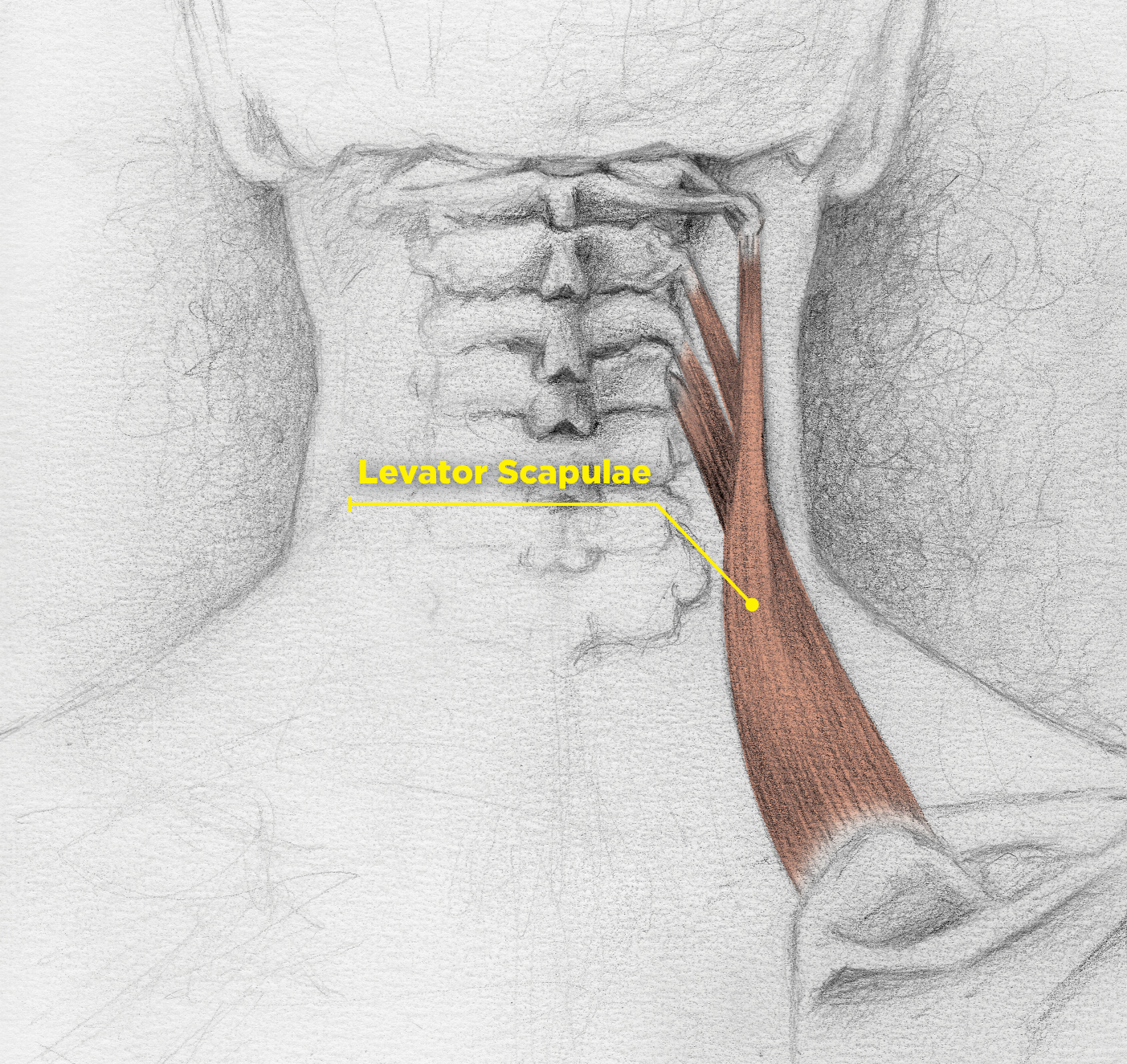It is Tough to Reach the Shoulder Blade Muscles
The levator scapulae is a headache-producing muscle that originates on your shoulder blade. This muscle sends out its ropy muscles to attach to the upper four vertebrae of your neck. Think of this muscle as an octopus, or half of one anyway, as it prepares to tighten up and squeeze your aching neck. An aching neck leads to headaches, which is no surprise to those of you dealing with this frustrating muscle.
This muscle is kind of like the mosquito that lands on your shoulder blade just out of reach of your hand. Likewise, this muscle evades your grasp so that you cannot massage it easily. You can reach the upper tendril-like portions of the muscle where they attach to your neck vertebrae, but the main body of the muscle lies just outside your reach.
How Do I Stretch the Levator Scapulae Muscle?
Look at how the levator scapulae muscle attaches to your shoulder blade, and where it attaches to your neck. Bend your neck away from the side that you want to stretch. Stretch a tight right levator scapulae by turning your neck left and bend your neck forward. Use the diagram to visualize how this muscle stretches with this technique.
How Do I Keep My Shoulder Blade Stable so that I Can Get a Good Stretch?
Stabilize your shoulder blade so that it does not ride up on your trunk if you hope to stretch out the muscle. Otherwise, your shoulder hunches as you turn your neck and bend it forward.
You can place your right arm behind you. As a result, your shoulder blade will be less likely to hunch up. However, your shoulder blade will still resist your effort to keep it in place.
The “Sheet Stretch” Stabilizes the Shoulder Blade
Place a sheet over your shoulder, cross the sheet over to your opposite thigh. Wrap this sheet around your thigh to anchor it. Check out this procedure in my book “Calming the Headache Storm.” You can see photos of these steps in Chapter 5, “Tension Headache Turmoil – Taming Tight Muscles.” With your foot planted, you can adjust the tension by moving your thigh towards or away from your other thigh.
As a result of you fixating the shoulder blade, you can stretch other headache muscles as well. Tighten up the sheet to stretch the upper trapezius and sternocleidomastoid. These muscles attach to both the shoulder blade and the neck. These two muscles are even more involved with headaches than the levator scapulae muscle. Fortunately, they are also easier to reach.
Muscle Misfiring
Your levator scapulae tightens up readily if you have a condition of muscle misfiring. We discussed this condition in an earlier blog called “A Weak Link in the Chain Can Cause Headache Havoc.”
The levator scapulae is a muscle that “hurts so good” when someone massages it. It also tightens up quickly when you start your daily activity again. The person with muscle misfiring tightens the muscle by simply walking to the car after their massage appointment.
What about Theracanes?
Theracanes, or regular hook canes for that matter, may give you the extra reach you need to work out this muscle. The disadvantage to the theracane is that you need to activate your levator scapulae muscle to get the cane into position to massage the same levator scapulae muscle. In effect, you work against yourself. Persevere, and make sure you get more units of relief from the cane than you expend to get that relief.
Check with your Doctor or Medical Professional
As with any technique, always check with your healthcare provider to make sure you do not have any medical problem that would interfere with a successful result. Do not massage if you are on blood thinners. Avoid any shooting pain into your arm as you stretch. Get clearance from your doctor if you have had any rotator cuff surgery before you do any shoulder blade or neck stretching techniques.
Try the pressure-free counterstrain technique, also described in Chapter 5 of my book, if your shoulder area cannot tolerate direct pressure to the levator scapulae. Physical therapy always provides numerous alternatives to solve your muscle problems!
-You understand that if not done properly, some techniques and exercises described in this blog could harm you. Any activities you perform are at your own risk, and you expressly agree to waive any claims against the author for any harm that may arise from your own actions. By reading this blog and conducting these exercises, you accept this risk. This blog provides content related to physical and/or mental health issues. As such, your use of techniques described acts as your acceptance of this disclaimer. Consult Chapter 2 in my book, “Calming the Headache Storm” to make sure the headache is not the sign of a more serious problem. The techniques, advice and strategies contained in this blog may not be suitable for every individual and should be abandoned if your headache increases. Seek the advice of your physician.
